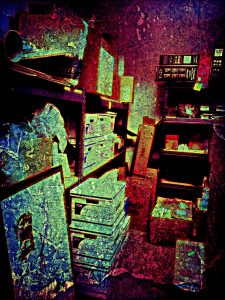Keynote address presented by Doctor Seeya Laterbro
Transcription services provided by Lisha E. Goldberg
Art by Dawn Vogel
Good morning. I am delighted to speak to all of you today at the International Symposium for Highly Frustrated Physicists. It’s been a wonderful conference, so far. Although I have to admit, I’m getting a little too old for the “Bodies in Motion Dance-a-thon.” Anybody else feeling a little sore this morning?
(Transcription note: Audience claps and laughs.)
And I’m definitely swearing off any beverage named “Big Bang” or “Cosmic Inflation.”
(Transcription note: More laughter and applause.)
Well, I’m happy to see that most of you have already prepared yourselves for today’s “Nikolai Tesla Look-Alike Contest.”
(Transcription note: Applause.)
Along those lines, let me give a shout out to Professor Mae Hemm for that gorgeous and fully functional Tesla Coil that she’s sporting in her hair.
(Transcription note: Applause and whistles.)
Yes, bravo Doctor Hemm! Speaking of Tesla, I want to share with you a problem that has confounded good old Saint Nick, along with all the other greats in our illustrious field. This issue began with the invention of that utilitarian depository receptacle known to modern science as the armarium repono, or, as some of you prefer to call it, the humble storage closet.
Because no one has ever actually named this phenomenon, I have taken it upon myself to designate it the Laterbro Paradox. In layman’s terms, the phenomenon works like this. You take a closet that is stuffed with stuff. You remove every piece of stuff from the closet. You dispose of one-half to three-quarters of the stuff. You then fold, organize, and return the remaining stuff to the closet. What happens? The remaining stuff no longer fits inside the closet.

Look familiar? A closet so full that as soon as the graduate student completes his assignment, unidentified falling objects bonk him on the head and knock him unconscious.
To read the rest of this story, check out the Mad Scientist Journal: Winter 2017 collection.
Doctor Seeya Laterbro graduated with a double doctorate in Physics and Chemistry from MIT’s prestigious correspondence program, Prank U. Laterbro received worldwide recognition with the publication of his first book, You don’t have to look like Einstein to be a Physicist (but it definitely helps in a job interview).
Dr. Laterbro was recently selected to serve aboard the International Space Station, where he will host NASA’s new television series, Far Flung Fashionistas.
In his free time, Dr. Laterbro enjoys hanging out with his llama and knitting sweaters with his protege, Ms. Oopsie Daisy.
Lisha Goldberg started her professional career as a technical writer, then switched to teaching science to elementary children. She enjoys writing short stories and poems. Her hobbies include playing piano, assisting at a riding school for special needs children, and creating artwork with mosaic tiles.
Dawn Vogel has been published as a short fiction author and an editor of both fiction and non-fiction. Although art is not her strongest suit, she’s happy to contribute occasional art to Mad Scientist Journal. By day, she edits reports for and manages an office of historians and archaeologists. In her alleged spare time, she runs a craft business and tries to find time for writing. She lives in Seattle with her awesome husband (and fellow author), Jeremy Zimmerman, and their herd of cats. For more of Dawn’s work visit http://historythatneverwas.com/.
“The Physics of Decluttering” is © 2017 Lisha Goldberg
Art accompanying story is © 2017 Dawn Vogel
